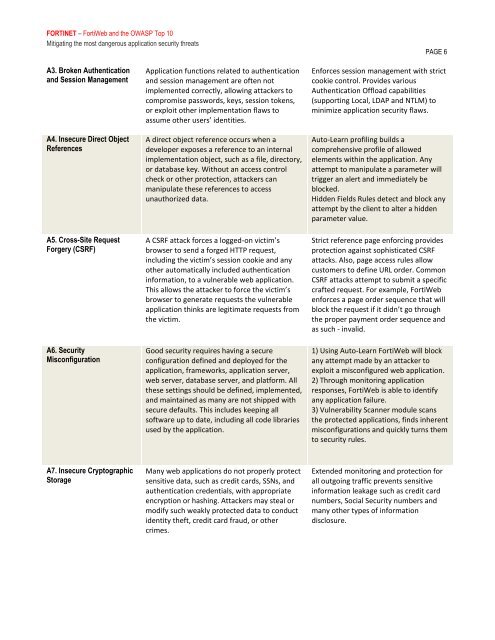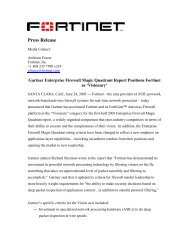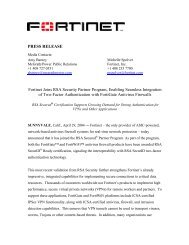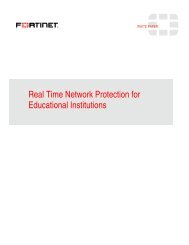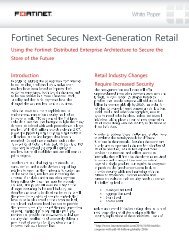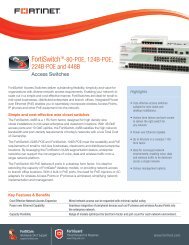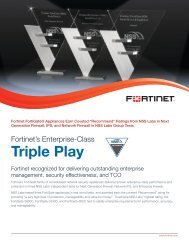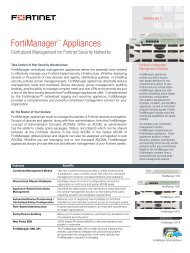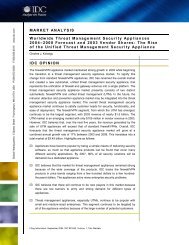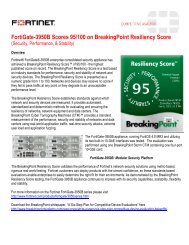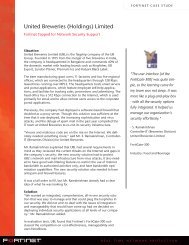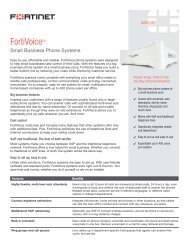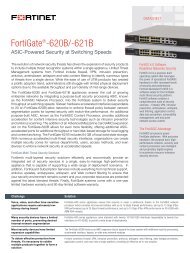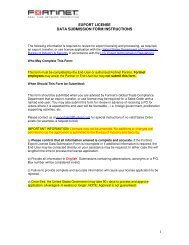FortiWeb and the OWASP Top 10 - Fortinet
FortiWeb and the OWASP Top 10 - Fortinet
FortiWeb and the OWASP Top 10 - Fortinet
Create successful ePaper yourself
Turn your PDF publications into a flip-book with our unique Google optimized e-Paper software.
FORTINET – <strong>FortiWeb</strong> <strong>and</strong> <strong>the</strong> <strong>OWASP</strong> <strong>Top</strong> <strong>10</strong><br />
Mitigating <strong>the</strong> most dangerous application security threats<br />
A3. Broken Au<strong>the</strong>ntication<br />
<strong>and</strong> Session Management<br />
A4. Insecure Direct Object<br />
References<br />
A5. Cross-Site Request<br />
Forgery (CSRF)<br />
A6. Security<br />
Misconfiguration<br />
A7. Insecure Cryptographic<br />
Storage<br />
Application functions related to au<strong>the</strong>ntication<br />
<strong>and</strong> session management are often not<br />
implemented correctly, allowing attackers to<br />
compromise passwords, keys, session tokens,<br />
or exploit o<strong>the</strong>r implementation flaws to<br />
assume o<strong>the</strong>r users’ identities.<br />
A direct object reference occurs when a<br />
developer exposes a reference to an internal<br />
implementation object, such as a file, directory,<br />
or database key. Without an access control<br />
check or o<strong>the</strong>r protection, attackers can<br />
manipulate <strong>the</strong>se references to access<br />
unauthorized data.<br />
A CSRF attack forces a logged-on victim’s<br />
browser to send a forged HTTP request,<br />
including <strong>the</strong> victim’s session cookie <strong>and</strong> any<br />
o<strong>the</strong>r automatically included au<strong>the</strong>ntication<br />
information, to a vulnerable web application.<br />
This allows <strong>the</strong> attacker to force <strong>the</strong> victim’s<br />
browser to generate requests <strong>the</strong> vulnerable<br />
application thinks are legitimate requests from<br />
<strong>the</strong> victim.<br />
Good security requires having a secure<br />
configuration defined <strong>and</strong> deployed for <strong>the</strong><br />
application, frameworks, application server,<br />
web server, database server, <strong>and</strong> platform. All<br />
<strong>the</strong>se settings should be defined, implemented,<br />
<strong>and</strong> maintained as many are not shipped with<br />
secure defaults. This includes keeping all<br />
software up to date, including all code libraries<br />
used by <strong>the</strong> application.<br />
Many web applications do not properly protect<br />
sensitive data, such as credit cards, SSNs, <strong>and</strong><br />
au<strong>the</strong>ntication credentials, with appropriate<br />
encryption or hashing. Attackers may steal or<br />
modify such weakly protected data to conduct<br />
identity <strong>the</strong>ft, credit card fraud, or o<strong>the</strong>r<br />
crimes.<br />
PAGE 6<br />
Enforces session management with strict<br />
cookie control. Provides various<br />
Au<strong>the</strong>ntication Offload capabilities<br />
(supporting Local, LDAP <strong>and</strong> NTLM) to<br />
minimize application security flaws.<br />
Auto-Learn profiling builds a<br />
comprehensive profile of allowed<br />
elements within <strong>the</strong> application. Any<br />
attempt to manipulate a parameter will<br />
trigger an alert <strong>and</strong> immediately be<br />
blocked.<br />
Hidden Fields Rules detect <strong>and</strong> block any<br />
attempt by <strong>the</strong> client to alter a hidden<br />
parameter value.<br />
Strict reference page enforcing provides<br />
protection against sophisticated CSRF<br />
attacks. Also, page access rules allow<br />
customers to define URL order. Common<br />
CSRF attacks attempt to submit a specific<br />
crafted request. For example, <strong>FortiWeb</strong><br />
enforces a page order sequence that will<br />
block <strong>the</strong> request if it didn’t go through<br />
<strong>the</strong> proper payment order sequence <strong>and</strong><br />
as such - invalid.<br />
1) Using Auto-Learn <strong>FortiWeb</strong> will block<br />
any attempt made by an attacker to<br />
exploit a misconfigured web application.<br />
2) Through monitoring application<br />
responses, <strong>FortiWeb</strong> is able to identify<br />
any application failure.<br />
3) Vulnerability Scanner module scans<br />
<strong>the</strong> protected applications, finds inherent<br />
misconfigurations <strong>and</strong> quickly turns <strong>the</strong>m<br />
to security rules.<br />
Extended monitoring <strong>and</strong> protection for<br />
all outgoing traffic prevents sensitive<br />
information leakage such as credit card<br />
numbers, Social Security numbers <strong>and</strong><br />
many o<strong>the</strong>r types of information<br />
disclosure.


